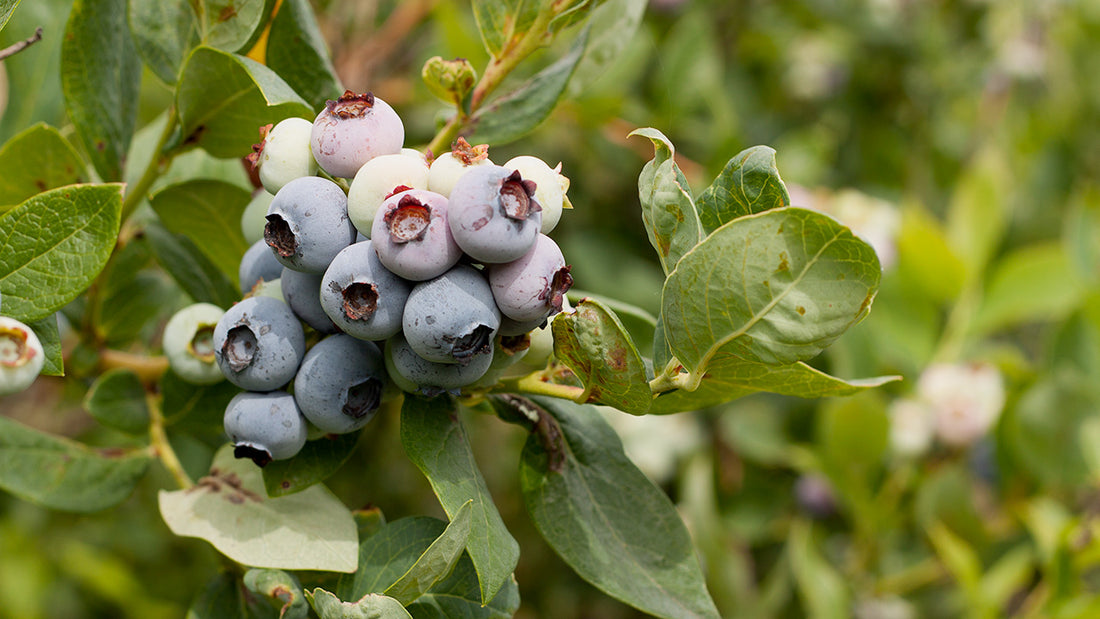Cultural Requirements
Delicious, exceptionally nutritious, high in bioflavonoids. Gardeners in warmer climates can enjoy growing blueberries and fruiting (any two varieties will do, regardless of ripening time) by choosing one of the Southern Highbush varieties. These require fewer chill hours than the Northern Highbush which require over 1000 hours. Consider climate suitability, ripening season and fruit size when selecting varieties and include at least two different varieties for cross-pollination. Grow in acidic, well drained soil. Cottonseed meal is an excellent fertilizer (although probably GMO and not certified organic) for blueberries along with good quality compost. Blueberries prefer an acidic, well-drained soil. Mulching with acidic materials has proved beneficial for soils that are not ideal for blueberry growing. Fir sawdust or bark dust, applied at a depth of two to four inches, also eliminates most of the need for cultivation and conserves moisture. Blueberries’ shallow, compact root system makes regular irrigation a necessity.
Heeling In
When your nursery stock arrives, it is best to plant them right away. If you cannot plant immediately (within a week of delivery), remove plastic bags that cover and keep the roots moist during shipment, and store them in a cool moist place like a root cellar or basement, making sure the roots stay moist and do not freeze. Or, you can “heel in” the plants to protect them. To heel in bare root plants outside, pick a location that is shielded from wind. Dig a trench with one side sloping and the other side vertically straight. Place the plants so that the roots are pointed toward the vertical side and the trunks /stems are supported by the sloping side. Cover the roots with soil and tamp it down to avoid air pockets. Heeling in should protect your plants until you are ready to plant. If you are unable to heel them in outside due to extremely cold temperatures, you can place the plants in a box with moist sawdust (do not, however, use cedar sawdust which is combustible) or dirt (by far the best and safest medium) covering the roots to hold them over. If using sawdust, be sure to carefully and regularly monitor the temperature to prevent “cooking” the roots if the sawdust starts to compost. The best preventative measure is to regularly water and aerate the pile without allowing the temperature to rise.
Planting Instructions
Blueberries ultimately reach a height of six feet or more with a spread of four feet or more. Therefore, the rows should be at least eight feet apart with plants spaced no closer than six feet apart, unless a hedge is desired. The top of the root clump should be close to the surface if a mulch is used or about four inches deep without mulch.
Fertility
For well-balanced mineral soils, a yearly application of an organic fertilizer, such as
Cottonseed meal, is ideal or another
fertilizer for acid-loving plants. It should be applied in early spring, on the surface of the mulch in a broad ring around the plant, regardless of plant size. The yearly addition of phosphorus or potassium or both are important for fruit production.
Fruit Production
Two different varieties must be planted to ensure cross pollination and fruit set. Any two varieties will cross pollinate regardless of ripening time. The early varieties begin ripening in June and the late varieties in early August. When planting two or three year old plants, the blossoms should be removed for a year or two to promote vegetative growth and development of a strong root system. Blueberries tend to over-bear rather than under-bear. Thinning blossoms will promote larger fruit and a healthier bush. A large plant may produce 15 to 20 pounds of fruit.
Pruning
After the plant is established, you may remove old wood. Some of the thrifty vegetative wood may be removed to prevent the plant from becoming too sprawling or too high. Blueberries become sweeter the longer they remain on the bush. The only reason to pick early (as they turn color), is to prevent the birds from eating them first. Home gardeners often protect their plants from birds with netting or bird scare tape. See our website for
bird repellent supplies.

